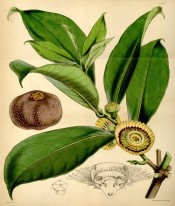Napoleonaea imperialis P.Beauv.
Frost tender evergreen shrub with elliptic leaves to 22cm long, and showy, saucer-shaped, solitary apricot and crimson flowers, sometimes in 2s and 3s, borne in the leaf axils of old wood. To 7m. [RHSD].
Horticultural & Botanical History
‘A more than ordinary interest has attached to this plant, arising partly from the circumstances under which the species was discovered, and partly from its name, given in honour of one of the most remarkable men that ever lived, and, still more, perhaps, from the singular structure and colour of the flower, as exhibited in the figure of the Baron Palisot de Beauvois;- so remarkable, indeed, that doubts have been expressed of the very existence of the plant. […] In 1843, Mr. Whitfield returned from one of his many voyages of Natural History research to Sierra Leone, a country, it will be observed, intermediate with Senegambia and Oware, and brought with him both living and dried specimens of Napoleona, the latter of which, after a most careful investigation, Dr. Lindley concludes to be identical with Beauvois’ plant, and I think with justice; for though, when recent, these flowers are described by Mr. Whitfield to be “apricot-coloured and crimson” yet the same traveller remarks that, when decaying, they assume a bluish tint: which will account for their colour, as described by Beauvois, “d’ un beau bleu, avec un reflet violet.”
The collection of plants formed by the unfortunate Dr. Vogel in the last voyage up the Niger, again contains specimens of a Napoleona, which Drs. Hooker and Planchon, who are mainly charged with the publication of that collection, pronounce distinct. Of this, as accurate a figure and description as can be drawn up from dried specimens, both of flower and fruit, are given in the 8th vol. of Hooker’s Icones Plantarum, t.800, and called N. Vogelii, Hook. et Planch.
At length, in 1848, one of the living plants, brought home by Mr. Whitfield and purchased by His Grace the late Duke of Northumberland, produced perfect flowers in the month of May. It was most obligingly and immediately sent to me, by Her Grace the Duchess Dowager, and from it our flowering specimen is taken. The representation of the fruit, it must be premised, is done from Vogel’s specimens, and consequently belongs to the N. Vogelii. Between that plant and ours, however, I can point out no difference, save in the shape and relative size of the leaves.’ [BM t.4387/1848]. FS p.1 vol.1/1845.
History at Camden Park
Listed in the 1850 and 1857 catalogues [T.697/1850]. Obtained from the London Horticultural Society and Kew Gardens. Included among desiderata in a letter to John Lindley dated 15th February 1848 [A2933-1, p.157] and to Kew at about the same time [MP A2933-1, p.165] and marked ‘arrived’ on Macarthur’s copies.
Notes
Napoleonaea imperialis Hook. (1848) may refer to Napoleonaea whitfieldii Van Houtte ex Lem. and be a similar but distinct species.
Published Mar 23, 2009 - 04:35 PM | Last updated Mar 24, 2010 - 05:30 PM
| Family | Lecythidaceae |
|---|---|
| Category | |
| Region of origin | Tropical East Africa |
| Synonyms |
|
| Common Name | |
| Name in the Camden Park Record | Napoleana imperialis |
| Confidence level | high |


